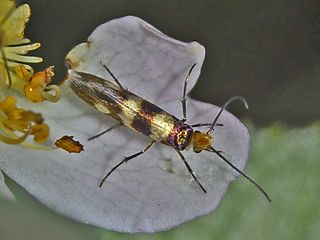Agathiphaga is a genus of moths, known as kauri moths. It is the only living in the family Agathiphagidae. This caddisfly-like lineage of primitive moths was first reported by Lionel Jack Dumbleton in 1952, as a new genus of Micropterigidae.

Micropterix is a genus of small primitive metallic moths, in the insect order lepidoptera within the family Micropterigidae. The name was raised by the German entomologist, Jacob Hübner in 1825 and comes from the Greek for mikros, little and pterux, a wing. The moths are distributed across Europe, south to North Africa and east as far as Japan.

Micropterix aureatella is a moth of the family Micropterigidae found in the Palearctic realm, except for North Africa.

Micropterix calthella, the marsh marigold moth, is a species of moth belonging to the family Micropterigidae. It is found in damp habitats throughout Europe and is also distributed eastwards to central Siberia. It was first described by Carl Linnaeus in 1761 as Phalaena calthella.

Micropterix aruncella is a species of moth belonging to the family Micropterigidae, which is distributed throughout Europe. The imago was first described by Giovanni Antonio Scopoli in 1763. This species is one of the best known members of the family, being found in a wide range of habitats from sea level to over 2,000 metres (6,600 ft); the only habitat not favoured by this species is dense woodland.

Sabatinca incongruella is a species of moth of the family Micropterigidae. It is endemic to New Zealand and is found only in the northern parts of the South Island. It is a day flying moth and is on the wing from mid January until late February. The larvae of this species feed on liverworts and the adult moths feed on the spores of fern species in the genus Pneumatopteris. This species can be confused with S. chalcophanes as it is very similar in appearance.

Micropterix tunbergella is a moth of the family Micropterigidae found in most of Europe. The moths are very small and can be found feeding on the pollen of hawthorn, oak and sycamore. The larva and pupa are unknown. The moth was described Johan Christian Fabricius in 1787.

Micropterix allionella is a moth of the family Micropterigidae. It was described by Johan Christian Fabricius in 1794.
Micropterix algeriella is a species of moth belonging to the family Micropterigidae. It was described by Émile Louis Ragonot in 1889 and is endemic to Algeria.
Micropterix eatoniella is a species of moth belonging to the family Micropterigidae. It was described by Heath in 1986. It is only known from the type locality Annaba in Algeria.
Micropterix facetella is a species of moth belonging to the family —Micropterigidae that was described by Zeller in 1851. Micropterix facetella has a 4 male facetalla to 1 female facetalla ratio and during the mating season female facetella are said to visit a flower, only to eat, and the male facetella are there for the purpose to mate. For the common ratio, the male facetella goes to a near by location that another male facetella was already there as a pursuit of competition. A competition on who will get the female first. That is why there is 4 males facetalla for every 1 female facetella. It is known from Croatia and Slovenia.
Micropterix fenestrellensis is a species of moth belonging to the family Micropterigidae. It was described by John Heath and T. Kaltenbach in 1984. It is known from Italy.
Tasmantrix is a genus of small primitive metallic moths in the family Micropterigidae.
Nannopterix is a genus of small primitive metallic moths in the familyMicropterigidae.
Micropterix rablensis is a species of moth belonging to the family Micropterigidae that was described by Zeller in 1868. It is probably restricted to Carinthia in Austria and to the adjacent areas of Styria in Austria and Italy and potentially of Slovenia. Its Croatian, Romanian and French existence is doubtful.

Sabatinca is a genus of small primitive metallic moths in the family Micropterigidae. Palaeomicra and Micropardalis were both established as subgenera of Sabatinca, but were both raised to generic level by Joël Minet in 1985. However in 2014 both these genera, Palaeomicra and Micropardalis, were recognised by George Gibbs as synonyms of Sabathica. Extinct species in this genus are known from the Cretaceous Burmese amber.
Palaeomicroides marginella is a species of moth belonging to the family Micropterigidae. It was described by Syuti Issiki in 1931. It is known from Taiwan.

Micropterigoidea is the superfamily of "mandibulate archaic moths", all placed in the single family Micropterigidae, containing currently about twenty living genera. They are considered the most primitive extant lineage of lepidoptera. The name comes from the Greek for mikros, little and pterux, a wing. The fossil record of the group goes back to the middle-late Jurassic with the earliest known species being Auliepterix from the Karabastau Formation in Kazakhstan.
Agrionympha fuscoapicella is a species of moth belonging to the family Micropterigidae. It was described by George W. Gibbs and Niels P. Kristensen in 2011. It is found in South Africa, where it is known only from Hogsback in the Eastern Cape. It occurs in tall dense rainforest, under the canopy but in light wells and margins where forest floor is damp and periphyton present.







